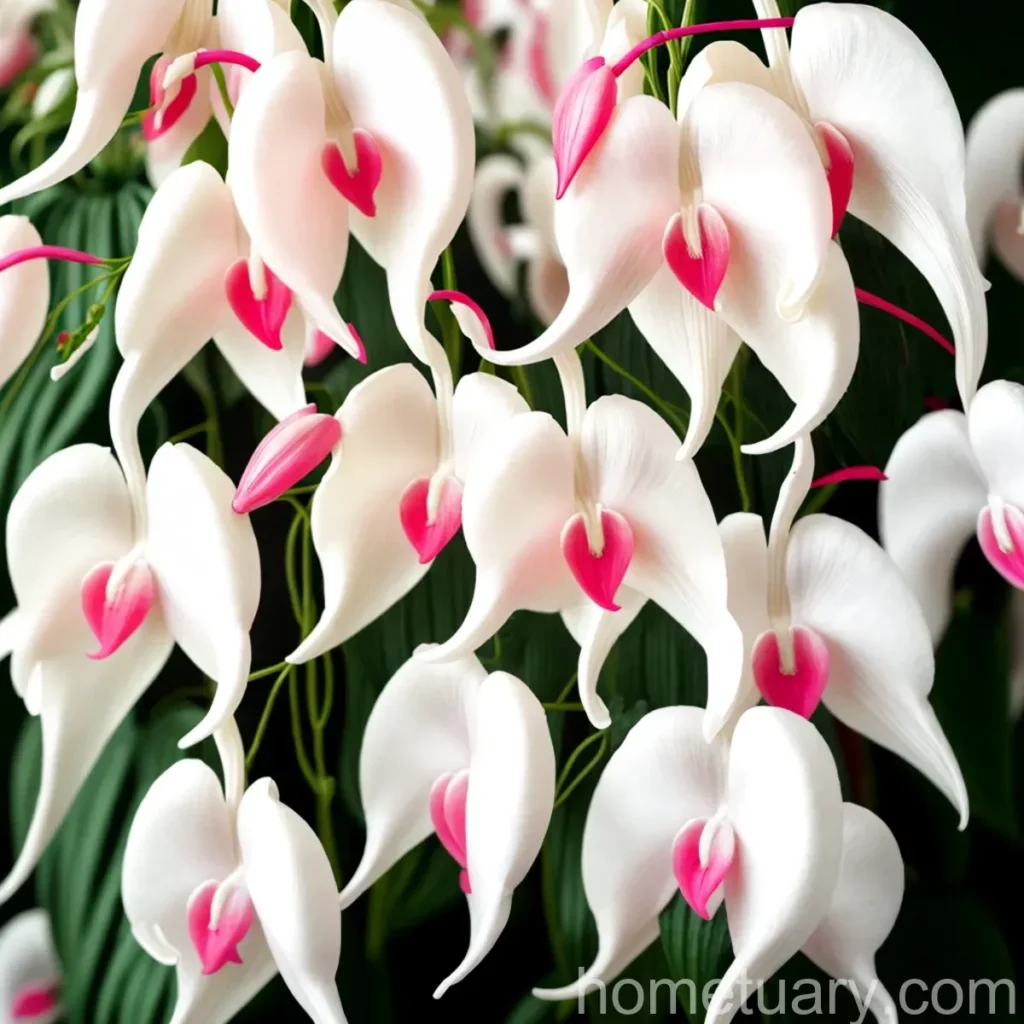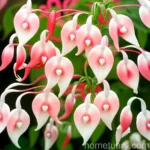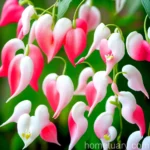All About the Bleeding Heart (Dicentra ‘Ivory Hearts’)
Bleeding heart, scientifically known as Dicentra ‘Ivory Hearts’, is a stunning and delicate perennial plant that captivates the hearts of many gardeners worldwide. With its unique heart-shaped flowers and graceful foliage, this plant adds elegance and charm to any garden. In this comprehensive guide, we will explore everything you need to know about the bleeding heart plant, from its cultivation to its uses and maintenance.
What is the Bleeding Heart (Dicentra ‘Ivory Hearts’)?
The bleeding heart is a herbaceous perennial plant that belongs to the Papaveraceae family. It is native to Siberia, northern China, Korea, and Japan, where it thrives in woodland environments. The plant is renowned for its distinct, heart-shaped flowers that dangle delicately from arching stems, giving it a unique and romantic appearance.
Key Takeaways about Bleeding Heart (Dicentra ‘Ivory Hearts’)
Before delving into the specific details of the bleeding heart plant, let’s take a quick look at its key takeaways:
- Common Name(s): Bleeding Heart, Ivory Hearts Bleeding Heart
- Scientific Name: Dicentra ‘Ivory Hearts’
- Plant Type: Herbaceous perennial
- Ideal Growing Conditions: Partial shade, moist well-drained soil
- Notable Feature: Unique heart-shaped flowers
Now, let’s explore in detail the various aspects related to the cultivation, uses, maintenance, and characteristics of the bleeding heart plant.
Culture of Bleeding Heart (Dicentra ‘Ivory Hearts’)
Caring for the bleeding heart plant involves understanding its specific cultural requirements to ensure its optimal growth and health. The following are the essential cultural factors to consider when cultivating Dicentra ‘Ivory Hearts’.
Water
Bleeding heart plants prefer consistently moist soil but are susceptible to root rot if the soil becomes waterlogged. They thrive in well-drained, moderately moist soil and benefit from regular watering, especially during dry periods. However, they do not tolerate standing water, so it’s crucial to achieve a balance in watering to prevent waterlogging.
Sunlight
In their natural habitat, bleeding heart plants are accustomed to shaded woodland areas and thrive in dappled or partial shade. They are not well-suited to intense, direct sunlight and can suffer leaf scorch if exposed to prolonged periods of harsh sun. Consequently, it’s important to provide them with a sheltered location that offers partial shade to maintain their health and vigor.
Fertilizer
When it comes to fertilizing the bleeding heart plant, a balanced, all-purpose fertilizer can be applied in early spring to support healthy growth and abundant flowering. Additionally, adding organic matter to the soil during planting can provide a nutrient-rich foundation for the plant to thrive.
Soil
The bleeding heart plant thrives in humus-rich, well-drained soil that retains moisture without becoming waterlogged. It is important to ensure that the soil is sufficiently moist but not overly wet, as excessively soggy conditions can lead to root rot.
Pruning
Pruning is an essential aspect of bleeding heart plant maintenance. After the plant has finished flowering, the stems and foliage can be trimmed back to promote a neat appearance and encourage fresh growth. Keeping the plant free from spent blooms and dead or damaged foliage can enhance its overall appearance and health.
Uses of Bleeding Heart (Dicentra ‘Ivory Hearts’)
Beyond its ornamental appeal, the bleeding heart plant has several notable uses, adding both aesthetic and practical value to gardens and landscapes.
Ornamental Value
The bleeding heart’s graceful and romantic appearance makes it a popular choice for enhancing the visual appeal of shaded gardens and woodland landscapes. Its distinctive heart-shaped flowers add a touch of whimsy and elegance, making it an ideal choice for both formal and informal garden settings.
Medicinal and Folklore Uses
Historically, various parts of the bleeding heart plant have been used in traditional medicine for treating certain ailments, although it is important to note that the plant contains toxic compounds and should not be ingested without proper medical supervision. Furthermore, the plant has been associated with various folklore and symbolic meanings in different cultures, adding to its mystique and allure.
Propagation of Bleeding Heart (Dicentra ‘Ivory Hearts’)
Propagating the bleeding heart plant allows gardeners to expand their collections and share the beauty of this stunning perennial with others. The following are the primary methods for propagating Dicentra ‘Ivory Hearts’:
-
Division: Division is one of the most common propagation methods for bleeding heart plants. It involves carefully dividing the plant into sections, each with its own roots, and replanting them to establish new plants.
-
Seeds: While bleeding heart plants can be grown from seeds, this method is less commonly used due to the extended germination period and the variability in the resulting plants. However, it can be a rewarding process for those interested in growing bleeding heart plants from scratch.
Bleeding Heart (Dicentra ‘Ivory Hearts’) in Containers
Bleeding heart plants can also thrive in container gardens, allowing individuals with limited garden space to enjoy their captivating beauty. When cultivating Dicentra ‘Ivory Hearts’ in containers, the following considerations are important:
-
Container Size: Use a container that provides ample space for the plant’s roots to establish and grow. It should also offer sufficient drainage to prevent waterlogging.
-
Potting Mix: Use a high-quality, well-draining potting mix that retains moisture without becoming waterlogged. A mix formulated for perennial plants can be suitable for growing bleeding heart in containers.
-
Placement: Position the container in a location that provides partial shade, replicating the plant’s preferred growing conditions in the garden.
Popularity of Bleeding Heart (Dicentra ‘Ivory Hearts’)
The undeniable charm and unique beauty of the bleeding heart plant have contributed to its enduring popularity among gardeners and plant enthusiasts. Its graceful flowers and elegant foliage have made it a sought-after addition to shade gardens and woodland landscapes.
Common Diseases of Bleeding Heart (Dicentra ‘Ivory Hearts’)
While the bleeding heart plant is relatively resilient, it can be susceptible to certain diseases that can affect its health and appearance. Understanding these potential ailments is essential for maintaining the well-being of Dicentra ‘Ivory Hearts’. The following are some common diseases that can affect bleeding heart plants:
Root Rot
Prolonged periods of waterlogging or excessively wet soil can lead to root rot, a potentially fatal condition for bleeding heart plants. Symptoms include yellowing, wilting, and eventual collapse of the plant. Ensuring proper drainage and avoiding overwatering can help prevent this condition.
Powdery Mildew
Powdery mildew is a fungal disease that can affect the foliage of bleeding heart plants, leading to the development of powdery white patches on the leaves. Pruning to improve air circulation and the application of appropriate fungicidal treatments can help manage this condition.
Leaf Spot
Leaf spot is characterized by the appearance of dark or discolored spots on the leaves of the bleeding heart plant. It can be caused by various fungal pathogens and can lead to leaf damage and defoliation. Managing moisture levels and using preventive fungicidal treatments can help control leaf spot.
Disease Diagnosis and Management
Diagnosing and managing diseases affecting bleeding heart plants involves careful observation and prompt intervention to address any issues. Effective disease management strategies include:
-
Regular Inspection: Routinely inspect the plant for any signs of disease, including changes in leaf color, texture, or overall appearance.
-
Cultural Practices: Implement cultural practices that promote plant health, such as proper watering, adequate air circulation, and maintaining overall garden hygiene.
-
Treatment: When necessary, utilize appropriate fungicidal treatments to manage fungal diseases and maintain the plant’s health.
Common Pests Affecting Bleeding Heart (Dicentra ‘Ivory Hearts’)
In addition to diseases, bleeding heart plants can be vulnerable to certain pests that can negatively impact their growth and appearance. Understanding these potential pests is vital for effectively protecting Dicentra ‘Ivory Hearts’. The following are some common pests that can affect bleeding heart plants:
Aphids
Aphids are small, sap-feeding insects that can infest the tender foliage and stems of bleeding heart plants. Their presence can lead to stunted growth, distorted leaves, and the development of honeydew on the plant.
Slugs and Snails
Slugs and snails are known for their voracious appetite for the foliage of many garden plants, including the tender leaves of bleeding heart. Their feeding can result in unsightly damage to the plant and may necessitate the implementation of control measures.
Botrytis Blight
Botrytis blight, caused by the fungus Botrytis cinerea, can affect the flowers and foliage of bleeding heart plants, leading to the development of fuzzy gray mold and potential deterioration of the plant’s overall health.
Botanist’s Tips for Growing Bleeding Heart (Dicentra ‘Ivory Hearts’)
Based on extensive knowledge and experience, botanists offer invaluable tips for successfully growing and caring for the bleeding heart plant, enhancing its beauty and ensuring its well-being. The following are some expert tips for cultivating Dicentra ‘Ivory Hearts’:
-
Sheltered Location: Choose a sheltered location with dappled or partial shade to provide the plant with its preferred growing conditions.
-
Moisture Management: Maintain consistent soil moisture without allowing water to stagnate around the plant’s roots to prevent the development of root rot.
-
Pruning: Practice regular pruning to remove spent blooms and maintain the plant’s overall appearance while stimulating new growth.
Fun Facts about Bleeding Heart (Dicentra ‘Ivory Hearts’)
The bleeding heart plant is not only captivating but also possesses some fascinating and delightful attributes, making it an intriguing subject for plant enthusiasts. Here are some fun and interesting facts about Dicentra ‘Ivory Hearts’:
- The bleeding heart plant is also known by the scientific name Dicentra spectabilis, reflecting its remarkable and showy nature.
- Its unique heart-shaped flowers have contributed to its association with various romantic and symbolic meanings in different cultures and traditions.
- The plant’s delicate and lacy foliage enhances its overall allure, adding to its appeal as a cherished garden plant.
Links to External Resources
For further exploration of the bleeding heart plant and related topics, the following external resources provide valuable insights and information:
- Royal Horticultural Society – Dicentra ‘Ivory Hearts’
- The Spruce – Bleeding Heart Plant Profile
- University of Vermont Extension – Bleeding Hearts in the Garden
Now that we have thoroughly explored the distinctive characteristics, cultivation, uses, and maintenance of the bleeding heart (Dicentra ‘Ivory Hearts’), it is evident that this enchanting plant holds a special place in the hearts of gardeners and nature enthusiasts. Its romantic blooms and graceful presence make it a standout feature in gardens and landscapes, captivating all who encounter its timeless allure. Whether cultivated in shaded gardens, woodland settings, or charming containers, the bleeding heart plant continues to enchant and inspire with its enduring beauty and elegance.















